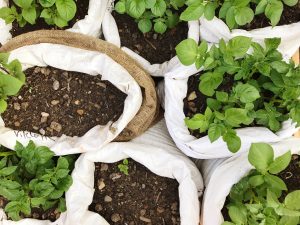Have you ever dreamed of growing your own potatoes but thought it was only possible for those with a sprawling backyard or a large garden? Think again! Imagine the satisfaction of harvesting your very own homegrown potatoes, all from the comfort of your indoor space. In this article, we will reveal the secret to successfully growing potatoes in a bag indoors, no green thumb is required. Get ready to embark on a culinary adventure and enjoy the taste of freshly dug spuds right at your fingertips.

Preparing The Bag And Soil For Planting
Preparing the bag and soil for planting is a crucial step in growing potatoes indoors. Begin by choosing the right bag, one that is sturdy and has good drainage holes. Opt for a fabric or burlap sack as opposed to plastic, as it allows for better air circulation around the roots.
Next, select high-quality soil that is loose, well-draining, and rich in organic matter. Avoid using garden soil which can be heavy and may contain pests or diseases. Instead, opt for a mix specifically formulated for container gardening or create your own blend by combining equal parts compost, peat moss, and vermiculite.
Before filling the bag with soil, place it in a location that receives at least six hours of sunlight each day. This will ensure optimal conditions for your potatoes to grow. Once positioned correctly, fill the bag with about 4-6 inches of moistened soil mix. It’s important not to overfill the bag initially to allow room for hilling later on.
Planting And Caring For Potato Plants Indoors
One of the first steps in planting and caring for potato plants indoors is selecting the right variety. While some potatoes are better suited for outdoor gardening, certain varieties thrive when grown in containers or bags indoors. Consider choosing compact or bushy varieties that won’t outgrow their pots easily and have a shorter growth period. This way, you can enjoy fresh and homegrown potatoes even if you have limited space.
When it comes to planting, start by filling your container with a well-draining potting mix or a mixture of soil and compost. Place two to three seed potatoes on top of the soil and cover them with another layer of soil or compost. Water thoroughly, ensuring the soil is evenly moist but not waterlogged. As your plants start growing, it’s essential to keep an eye out for any signs of overcrowding or competition for resources among the plants. Thin out weaker shoots so that the stronger ones can receive adequate sunlight, water, and nutrients.

Harvesting And Storing Your Homegrown Potatoes
Harvesting and storing your homegrown potatoes is an exciting and gratifying process that allows you to fully enjoy the fruits of your labor. Once your potato plants have reached maturity, it’s time to start harvesting! Gently dig around the base of the plant with a garden fork or shovel, being careful not to damage the tubers. As you unearth each potato, marvel at its size and shape – it’s like unearthing hidden treasures!
After harvesting your homegrown potatoes, proper storage is crucial for long-term enjoyment. Begin by removing any excess soil or debris from the tubers. Avoid washing them as this can remove their protective outer layer and increase the risk of spoilage. Instead, let them air dry for a few hours before transferring them to a cool, dark, and well-ventilated space – ideally between 45-55°F (7-13°C). Surrounding them with newspaper or burlap sacks can help maintain humidity levels while preventing excessive moisture buildup.
By following these simple steps for harvesting and storing your homegrown potatoes, you can ensure they stay fresh and delicious throughout the year. Don’t forget to label your stored potatoes with their variety name and harvest date – this will come in handy when deciding which ones to use first! With proper care, you’ll be able to savor the flavors of your hard work in various culinary creations from creamy mashed potatoes to crispy fries all year round
Troubleshooting Common Potato Growing Problems
Potatoes are a staple in many households, and growing them indoors can be a convenient way to ensure a fresh supply throughout the year. However, even with the best intentions and care, common potato-growing problems can arise.
- One of the most frustrating issues is potato plants not producing tubers or only producing small ones. This problem can often be attributed to overcrowding. Potatoes need space to spread out their roots and grow tubers properly. If you notice that your plants are not producing any tubers or only small ones, it may be time to thin them out. By removing some of the weaker plants or spacing them out more evenly, you give each plant more room to thrive and develop larger tubers.
- Another common issue when growing potatoes indoors is poor drainage. Excess water can lead to root rot, stunted growth, and an overall unhealthy plant. To combat this problem, make sure your containers have plenty of drainage holes in the bottom and add a layer of gravel or broken pottery shards before adding the soil. This will help excess water flow out of the container rather than sitting around the roots.
By troubleshooting these common potato-growing problems, you can increase your chances of success when growing potatoes indoors in bags. Remember to provide enough space for each plant’s growth and ensure proper drainage for optimal results. With patience and perseverance, you’ll soon be enjoying delicious homegrown potatoes all year round!
Conclusion:
In conclusion, growing your own potatoes indoors in a bag can be a highly rewarding experience. Not only do you get to enjoy the process from start to finish, but you also get to savor the wonderful taste and texture of homegrown potatoes. The satisfaction derived from knowing that you have successfully nurtured these humble tubers from seed to harvest is truly unparalleled.
One of the most significant benefits of growing potatoes indoors is that it allows you to have a fresh supply of this versatile vegetable all year round. No longer will you need to rely on store-bought alternatives that may lack flavor or freshness. Instead, you can confidently serve up delicious dishes infused with the earthy goodness and nutritional value of your very own homegrown spuds.
Furthermore, cultivating potatoes in bags indoors opens up a world of possibilities for urban gardeners and those with limited outdoor space. Whether you live in an apartment or have a small backyard, this method enables you to grow your own food regardless of size constraints. In addition, it provides an engaging activity for individuals who want to connect with nature and experience the joy of gardening firsthand.
So why not give indoor potato growing a try? With just a few simple steps and some tender love and care, you’ll soon find yourself reaping the rewards – both in terms of yield and personal satisfaction – as you serve up plate after plate brimming with hearty homemade meals featuring the fruits (or rather, tubers) of your labor.






Be First to Comment